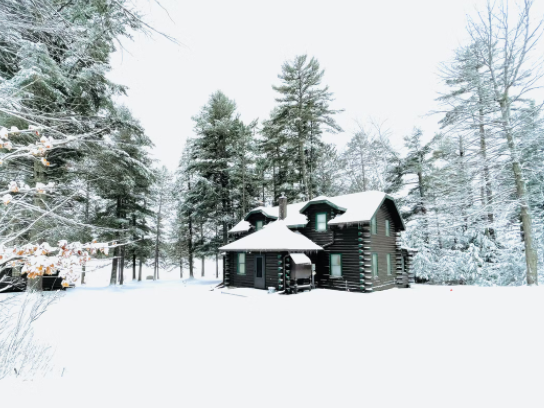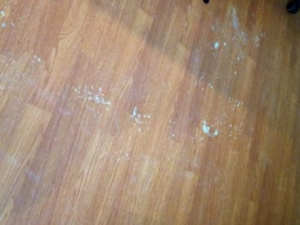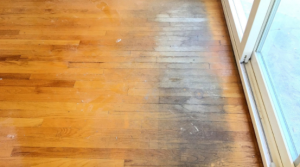The Effect of Salt and Snow on Hardwood Floors
February 23, 2022
At MacDonald Hardwoods, we love everything to do with hardwood floors. It’s our passion and the subject we know the most about. So as hardwood lovers, we do our best to preserve our floors and teach others how to do the same. Something that not many people talk about is the effect that salt and snow have on hardwood floors. That’s what we will be discussing.
Let’s get right into it.
The Relationship Between Salt and Snow
First, you are probably wondering how exactly salt gets onto your floors and why it matters. It’s important to keep our walkways safe during the winter when it gets icy. No one wants to see their mailman trip and fall. With that in mind, it’s become common for homeowners to sprinkle rock salt onto their walkways in advance of snow.
This works great and the walkways become safe to walk on. However, a side effect is that when the snow melts you can no longer see the salt. That is until it is tracked into your home from everyone’s shoes. By the time you realize what’s going on, your floors are already damaged.
How Does Salt Damage Hardwood?

source: unsplash
The crystals that come from calcium chloride are the issue. These crystals can really damage a hardwood floor finish. At a microscopic level, you would see small, rough-edged particles from salt. The rough edges unfortunately are able to ruin hardwood when stepped on or dragged across the floor. Both finished and unfinished hardwood are at risk.
Salt stains often leave a white film or residue. It’s rather unsightly. So if you live in an area where it snows frequently and you have to use rock salt outdoors, you should pay extra close attention to the solutions and prevention section further down.
How Does Snow Damage Hardwood?

source: unsplash
Compared to snow, this is a bigger issue.
When snow gets onto your hardwood floors, it doesn’t cause immediate damage. Snow isn’t the real problem. But once the snow melts and turns into water, the water saturates the entire floor, and this condition is often referred to as cupping. After some time, a lot of moisture is absorbed into the underside of the wooden boards, which then expands the bottom of each board more than the top. As a result, the hardwood takes on a wavy appearance in addition to each course of wood being raised at their seams.
Water-damaged hardwood more often happens due to leaks rather than just tracking in snow. However, snow is still able to cause damage when the source is snow from your roof. On your roof, when the snow melts into water and then freezes into ice, this is a serious problem that can lead to something called ice damming. Ice dams form at the edge of a roof and prevent water from draining off the roof, which leads to the water having to back up behind the dam, leading to leaks inside your home. This happens because the water that gets stuck finds cracks and openings in the exterior of your roof covering which is the entry point into the home.
When dealing with this issue, the most challenging part is waiting for the floors to dry out, knowing that there isn’t much you can do at the moment. If you are lucky and your floors are cupped like a washboard, they have the unique ability of being able to flatten out over time, which means you can avoid replacement. Most people have to wait a week for the water to dry out, which is then a good time to call in a flooring contractor.
The flooring contractor will perform a moisture test, and depending on the result, you may have to wait a few extra weeks because of how long it takes the water to dry. There isn’t much of anything to be done during this time. But after the moisture readings are consistent throughout the whole room, the process of repair or refinishing can begin.
It’s very important that your contractor doesn’t sand your floors before the floor is completely dry. If they do it anyway, you will unfortunately be left with something called crowning, which is basically the effect of cupping but in reverse.
If you don’t address potential water damage to your hardwood, the structure of your home can be at risk due to the growth of mold. Mold grows and spreads very quickly and will eat away at anything in its path.
Solutions and Prevention
It’s not the end of the world (at least not yet!). If you’re quick enough to react, you can usually get away with not having to pay for replacement hardwood when there is damage from salt and or snow.
Put a heavy rug in front of your door and in the doorway. Rather than salting the outside of your door, having rugs in place is extremely valuable. Wipe your shoes on the rugs.
Knock snow, salt, dirt, and other particles off your shoes before entering. Most people have something near the door that they can kick a few times. The force of the kick is able to get rid of most unwanted things.
Remove shoes upon entry. In most of the world, this is common sense. But here in America, most people wear their shoes anywhere in the home. With respect to the longevity of your hardwood, this is a big no-no.
Have waterproof mats available at the door. Once you’ve kicked nasty things off your shoes, and wiped them on the rug, you should then remove your shoes and put them onto a waterproof mat where they are able to safely dry out.
Have water-absorbent cloths nearby. The entrance of your home is where most issues start, so you should have cloths or towels at the door ready to wipe up any excess snow, dirt, water, etc., as needed.
Vacuum your hardwood floors regularly. You already are familiar with vacuuming carpet, but hardwood can also be vacuumed. This is a great way to get rid of salt, sand, dirt, and even water in some cases. It’s best to have a vacuum made for hardwood floors.
Have a roofing contractor come by during the winter. Your roofing contractor will easily be able to identify ice damming or the potential of it and find solutions with you so you don’t have to worry about leaks. And if there’s no issue, which there often isn’t, it won’t cost much at all for them to come by and just spend a few minutes with you finding that out.
Use hardwood floor cleaning products. A popular DIY solution that totally shouldn’t be used is vinegar, which often leaves a residue of its own. Be careful about the products that you use!
Contact your flooring contractor for advice. Your flooring contractor will be able to figure out if replacements are needed or if sanding, refinishing, and filling in splintered or corroded areas is possible.
Final Thoughts
Overall, hardwood floors are extremely durable, especially when compared to their carpet counterparts. There are only a small amount of drawbacks, and dealing with salt and snow is one of those drawbacks. The best way to manage the issue is by preventing it from happening in the first place. And if you follow the tips in this blog post, you will definitely be able to do that.
If you’re in Colorado and you haven’t already done so, you can get a quote on your unique flooring needs by using this link or by calling us at (800) 639-3006.






